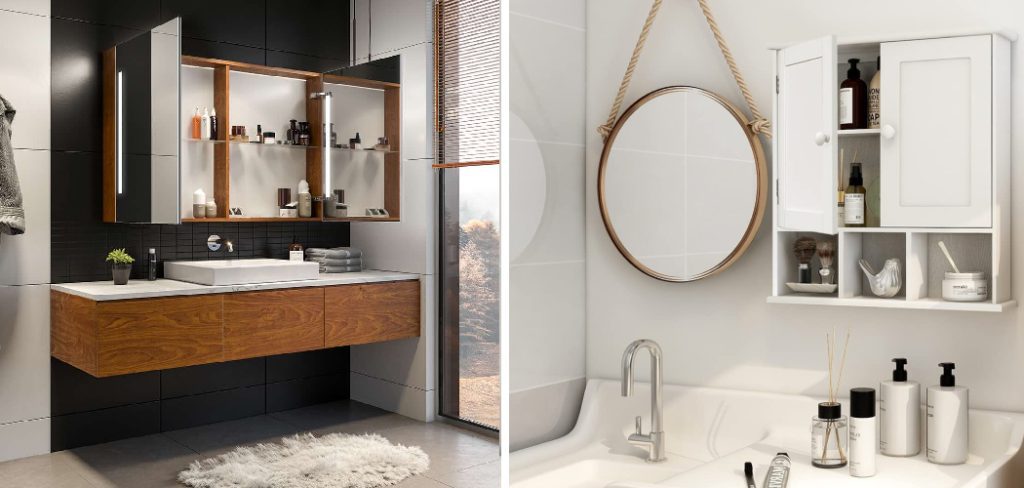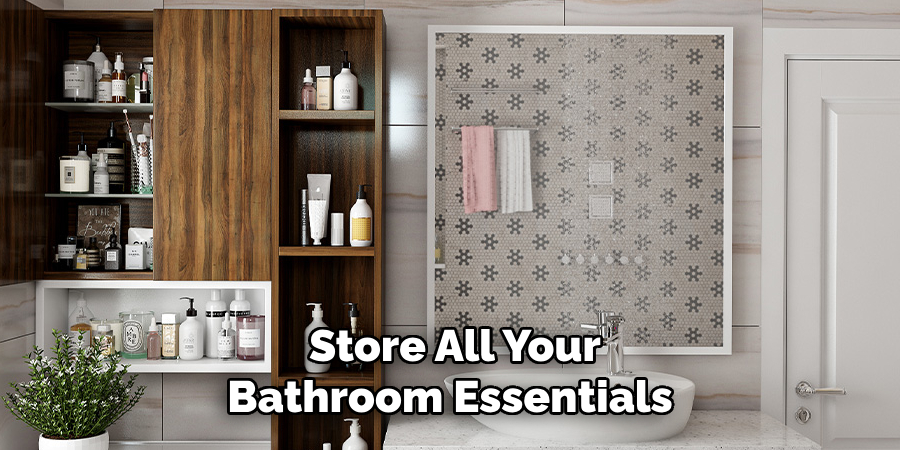Measuring a medicine cabinet accurately is a crucial step in either replacing an existing cabinet or installing a new one. Ensuring the correct dimensions will not only affect how well the cabinet fits into its intended space but also its functionality and overall aesthetic appeal in your bathroom or wherever it is placed.

This guide on how to measure a medicine cabinet will take you through the essential steps and tips to measure a medicine cabinet effectively, providing you with the knowledge required to make informed choices about your bathroom storage solutions.
What is a Medicine Cabinet?
A medicine cabinet is a storage unit that is typically mounted on the wall, commonly above a sink or vanity, and used to store medicines, toiletries, and other bathroom essentials. These cabinets come in various shapes, sizes, and designs to suit the needs and preferences of different individuals.
You can choose between framed or frameless cabinets, surface-mounted or recessed models, and different materials such as wood, metal, or plastic. The dimensions of these cabinets vary greatly, so it is crucial to know the right way to measure them to ensure a perfect fit.
The Importance of Accurate Measurements
Measuring your medicine cabinet accurately ensures that it fits perfectly in the designated space without any gaps or overlaps. This is important not just for aesthetic purposes but also for functionality. A cabinet that is too small may not provide enough storage space, while one that is too large can look bulky and overpower the rest of the bathroom decor.
In addition, accurate measurements are crucial for properly planning the placement of your cabinet’s shelving, doors, and other features. This will ensure that you have enough room to store all your bathroom essentials and that they are easily accessible.

You also want to make sure that the cabinet does not obstruct any other bathroom fixtures, such as lighting or outlets. Accurate measurements can help you avoid any potential issues and save you from having to make costly adjustments later on.
Tools Required
To measure a medicine cabinet, you will need the following tools:
Measuring Tape:
This is an essential tool for measuring the dimensions of your cabinet accurately. Make sure to use a flexible measuring tape as it will allow you to get precise measurements of curved or irregularly shaped cabinets.
Pencil and Paper:
Having a pencil and paper on hand will help you note down your measurements and keep track of them easily. This will also come in handy when comparing the measurements to the available cabinet sizes.
Step Stool or Ladder:
If your medicine cabinet is mounted high on the wall, you may need a step stool or ladder to reach it comfortably and take accurate measurements.
10 Step-by-step Guidelines on How to Measure a Medicine Cabinet
Step 1: Preparing for Measurement
Before you start measuring, make sure to remove any items that may be inside the cabinet. This will give you a clear view and access to the interior of the cabinet, making it easier to measure accurately.

The cabinet should also be empty when you install it to avoid any unnecessary weight. You should also clean the cabinet so it is free from any dust or debris that may affect your measurements.
It is also a good idea to turn off any lights or fans in the bathroom to avoid shadows or movement that can make measuring difficult.
Step 2: Measure the Width
Using your measuring tape, measure the width of the cabinet from one end to the other. For framed cabinets, this should include the frame as well.

Note down this measurement on your paper. It is essential to take the width measurement at both the top and bottom of the cabinet, as walls may not always be perfectly straight. You should use the smaller of these two measurements for a more accurate fit.
But, if the difference between the two measurements is significant, it may be a good idea to measure at several points in between and use an average of all the values. This will ensure a precise fit and avoid any gaps or overlaps.
Step 3: Measure the Height
Measure the height of your cabinet from top to bottom. If your cabinet has legs or feet, make sure to include them in the measurement. Again, take measurements at different points and use the smallest one for accuracy.
The height measurement is especially crucial for recessed cabinets, as you will need to make sure that it fits into the wall cavity.
It is also essential to consider any fixtures, such as lighting or outlets, that your cabinet may need to clear. The height of your cabinet should be slightly smaller than the available space to ensure a comfortable fit.
Step 4: Measure the Depth
Measure the depth of your medicine cabinet from the back to the front, including any protrusions such as knobs or handles. This measurement will determine how much space your cabinet takes up and should be considered carefully to avoid obstructing other bathroom fixtures.
You will also need to take into account the door swing, which is the amount of space needed for the cabinet door to open and close comfortably. For surface-mounted cabinets, this measurement is especially crucial as you want to make sure that the cabinet does not stick out too much from the wall.
Step 5: Measure Your Bathroom Space
Using your measuring tape, determine the available space in your bathroom where you plan to install the cabinet. Make sure to measure the width, height, and depth of the area accurately.

This will give you an idea of what size cabinet will fit comfortably in that space. It is crucial to leave some extra space on all sides of the cabinet for installation and maintenance purposes. You should also consider any other bathroom fixtures in the area and make sure that the cabinet will not obstruct them.
Step 6: Consider Your Needs
When choosing a medicine cabinet, it is essential to consider your storage needs as well. Think about what items you will be storing in the cabinet and how much space they will require. This will help you determine the number of shelves and their placement to maximize storage efficiency.
But, make sure not to overcrowd the cabinet as it can make it challenging to find and access items. The goal is to have enough space for your essentials while keeping the cabinet organized and clutter-free.
Step 7: Choosing a Cabinet Style
Now that you have accurate measurements of your bathroom space, it is time to choose a cabinet style that suits your needs and preferences. Consider factors such as the material, color, and design that will complement your bathroom decor.
You also want to make sure that the style of the cabinet aligns with your storage needs. For example, if you need more shelves for smaller items, a cabinet with multiple adjustable shelves may be the best option.

Step 8: Determine Mounting Style
There are two types of mounting styles for medicine cabinets: recessed and surface-mounted. Recessed cabinets are installed inside the wall cavity, while surface-mounted cabinets are attached directly to the wall.
Depending on your bathroom space and preferences, you will need to choose the most suitable mounting style for your cabinet. Keep in mind that recessed cabinets may require more installation work, but they provide a sleeker look as they do not stick out from the wall.
Step 9: Check for Installation Requirements
Before making a final decision on your cabinet, make sure to check any specific installation requirements. This may include things like wall studs, electrical wiring, or plumbing that can affect the placement and installation of your cabinet.
It is essential to address these requirements beforehand to avoid any surprises during the installation process. You may need to consult a professional if you are unsure about any installation requirements.
Step 10: Purchase and Install Cabinet
Once you have all the necessary information, it is time to purchase your medicine cabinet and prepare for installation. Follow the manufacturer’s instructions carefully, making sure to use the appropriate tools and techniques. Remember to take accurate measurements during the installation process as well to ensure a perfect fit.

Once your cabinet is installed, you can enjoy the added storage and functionality it provides in your bathroom. So, follow these steps carefully and choose the right medicine cabinet for your needs to enhance the look and organization of your bathroom.
Following these steps on how to measure a medicine cabinet carefully will help you choose the right medicine cabinet for your needs and ensure a proper fit in your bathroom. It is essential to take accurate measurements, consider your storage needs, and choose a suitable style and mounting option.
It is also crucial to address any installation requirements beforehand and follow the manufacturer’s instructions during installation. With the right medicine cabinet, you can elevate the look and functionality of your bathroom while keeping it organized and clutter-free.
Additional Tips

- If you are replacing an old cabinet, make sure to measure its dimensions instead of relying on the existing hole in your wall.
- Consider adding extra lighting inside or outside of your cabinet for added functionality and aesthetic appeal.
- Opt for adjustable shelves to customize the storage space according to your needs.
- Don’t be afraid to mix and match different styles, materials, and colors to create a unique look in your bathroom. Just make sure they complement each other well. So, follow these steps carefully and choose the right medicine cabinet for your needs to enhance the look and organization of your bathroom.
- When installing a recessed cabinet, make sure to use a level to ensure it is straight and centered in the wall cavity.
- If you are not confident in your installation skills, don’t hesitate to hire a professional for assistance. It is better to have the cabinet installed correctly than risk damaging your wall or the cabinet itself.
- Regularly clean and organize your medicine cabinet to maintain its functionality and aesthetics. By following these additional tips, you can ensure a successful and functional medicine cabinet installation in your bathroom. Remember to consider your needs, measurements, style and mounting options before making a purchase, and always follow proper installation techniques for a seamless addition to your bathroom space.
Consulting Manufacturer Guidelines
Finally, it is essential to always consult the manufacturer’s guidelines when purchasing and installing a medicine cabinet. Each cabinet may have specific instructions or requirements to ensure proper installation and functionality.
This will also help you understand any warranty or maintenance information for your cabinet. Don’t hesitate to reach out to the manufacturer if you have any questions or concerns during the process. With these steps and tips, you can confidently choose and install the perfect medicine cabinet for your bathroom.
You now have all the information and guidance you need to make an informed decision about your medicine cabinet. Remember to carefully consider your storage needs, take accurate measurements, and follow proper installation techniques for a successful outcome. With the right medicine cabinet, you can enhance the look and organization of your bathroom while adding valuable storage space.
Troubleshooting Common Measurement Issues:
- If you are unsure about the measurement of your recessed cabinet, add a few inches to your measurements to ensure it will fit properly. It is always better to have extra space than not enough.
- When measuring for a surface-mounted cabinet, make sure to take into account the depth and width of the cabinet, as well as any overhangs or decorative features.
- If your measurements do not align with standard cabinet sizes, consider customizing a cabinet or opting for a different style or mounting option.
- In case of any discrepancies between the manufacturer’s instructions and our general guidelines, always follow the manufacturer’s guidelines. They will have the most accurate information about their specific product.
By keeping these troubleshooting tips in mind, you can avoid common measurement issues and ensure a successful installation of your medicine cabinet.
Frequently Asked Questions
Q: Can I Install a Medicine Cabinet on My Own?
A: It is possible to install a medicine cabinet on your own, but it requires some basic knowledge of tools and proper installation techniques. If you are not confident in your skills, consider hiring a professional for assistance.
You don’t want to risk damaging your wall or cabinet during the installation process.
Q: How Much Does a Medicine Cabinet Cost?
A: The cost of a medicine cabinet can vary depending on the size, style, and material. Generally, they can range from $30 to $500 or more. It is essential to consider your budget and needs before making a purchase.
The added storage and functionality of a medicine cabinet may be worth the investment. But there are also budget-friendly options available.
Q: Can I Customize My Medicine Cabinet?
A: Some manufacturers offer customization options for their cabinets, such as adjustable shelves or different finishes.
You can also consider adding additional features, such as extra lighting or a built-in magnifying mirror, to personalize your cabinet further. However, keep in mind that customization may come at an additional cost.
Q: How Often Should I Clean and Organize My Medicine Cabinet?
A: It is recommended that you clean and organize your medicine cabinet at least once every three months. This will help you keep track of expired medications and maintain the functionality and aesthetics of your cabinet.
Regular maintenance will also prevent any potential safety hazards, such as mixing expired medications with new ones. By regularly cleaning and organizing your medicine cabinet, you can ensure its longevity and avoid any potential issues in the future.
Q: Can I Use a Medicine Cabinet for Storage Other Than Medications?
A: Yes, you can use your medicine cabinet to store other items such as toiletries, first aid supplies, or small bathroom essential items. Just make sure not to overload the shelves and keep them clean and organized.
Using your medicine cabinet for multiple purposes can help save space in your bathroom and keep it clutter-free. However, always avoid storing items that may be affected by humidity or heat from your shower, such as makeup or electronic devices.
Conclusion
A medicine cabinet is an essential addition to any bathroom. It not only adds valuable storage space but also enhances the look and organization of your bathroom. By following these steps on how to measure a medicine cabinet, you can confidently choose and install the perfect medicine cabinet for your needs.
Remember to consider your storage needs, take accurate measurements, and follow proper installation techniques for a successful outcome.
Don’t hesitate to consult a professional if needed, and always refer to the manufacturer’s guidelines for specific instructions. With the right medicine cabinet, you can elevate your bathroom space and enjoy a clutter-free and functional area.
So, follow these steps carefully and choose the right medicine cabinet for your needs to enhance the look and organization of your bathroom.